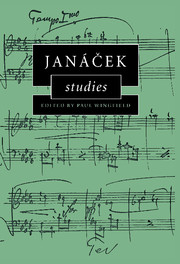Book contents
- Frontmatter
- Contents
- Preface
- 1 Expressive sources and resources in Janáček's musical language
- 2 ‘Nothing but pranks and puns’: Janáček's solo piano music
- 3 Narrative in Janáček's symphonic poems
- 4 Evasive realism: narrative construction in Dostoyevsky's and Janáček's From the House of the Dead
- 5 Direct discourse and speech melody in Janáček's operas
- 6 Kundera's eternal present and Janáček's ancient Gypsy
- 7 Janáček's folk settings and the Vixen
- 8 Janáček's operas in Australia and New Zealand: a performance history
- 9 Janáček's Moravian publishers
- 10 Janáček, musical analysis, and Debussy's ‘Jeux de vagues’
- Index
2 - ‘Nothing but pranks and puns’: Janáček's solo piano music
Published online by Cambridge University Press: 22 September 2009
- Frontmatter
- Contents
- Preface
- 1 Expressive sources and resources in Janáček's musical language
- 2 ‘Nothing but pranks and puns’: Janáček's solo piano music
- 3 Narrative in Janáček's symphonic poems
- 4 Evasive realism: narrative construction in Dostoyevsky's and Janáček's From the House of the Dead
- 5 Direct discourse and speech melody in Janáček's operas
- 6 Kundera's eternal present and Janáček's ancient Gypsy
- 7 Janáček's folk settings and the Vixen
- 8 Janáček's operas in Australia and New Zealand: a performance history
- 9 Janáček's Moravian publishers
- 10 Janáček, musical analysis, and Debussy's ‘Jeux de vagues’
- Index
Summary
The growing recognition of Janáček as a true radical, rather than a crank, has two primary bases: the technical daring of his orchestration, and the dramatic works' uniquely intense relationship between linguistic and musical motivic expression. Innovations are, therefore, far less frequently identified in his solo piano music, whether because its instrumental sonority appears closer to convention than is the case with the orchestral work, or because Janáček's single most far-reaching quality, seen at its purest in these pieces, is still generally underestimated: the redefinition of structural tonality through an unprecedented concentration on ambiguous, and particularly enharmonic, key relationships.
Volatility of texture and economy of material combine in the mature Janáček to give a relationship between harmonic colour and underlying tonality more highly-charged than in any other composer. Na památku (In memoriam), thought to date from 1886–7, sows the seeds of all the major piano works to come (Example 2.1).
Each of the three paragraphs is underpinned by a perfect-fifth pedal, giving an apparent ABA tonal structure of A♭ – V of E – A♭; yet it makes no sense to describe these pedals as functions of a tonal scheme. The low B1/F# dyad of bb.9–15 is not resolved at any stage; neither in b.16, nor in b.17, with its extraordinary second inversion, nor even in the closing bars of the piece. The sense of resolution in the last four bars is far from merely rhetorical; but tonality is only tangentially involved.
- Type
- Chapter
- Information
- Janácek Studies , pp. 18 - 35Publisher: Cambridge University PressPrint publication year: 1999



